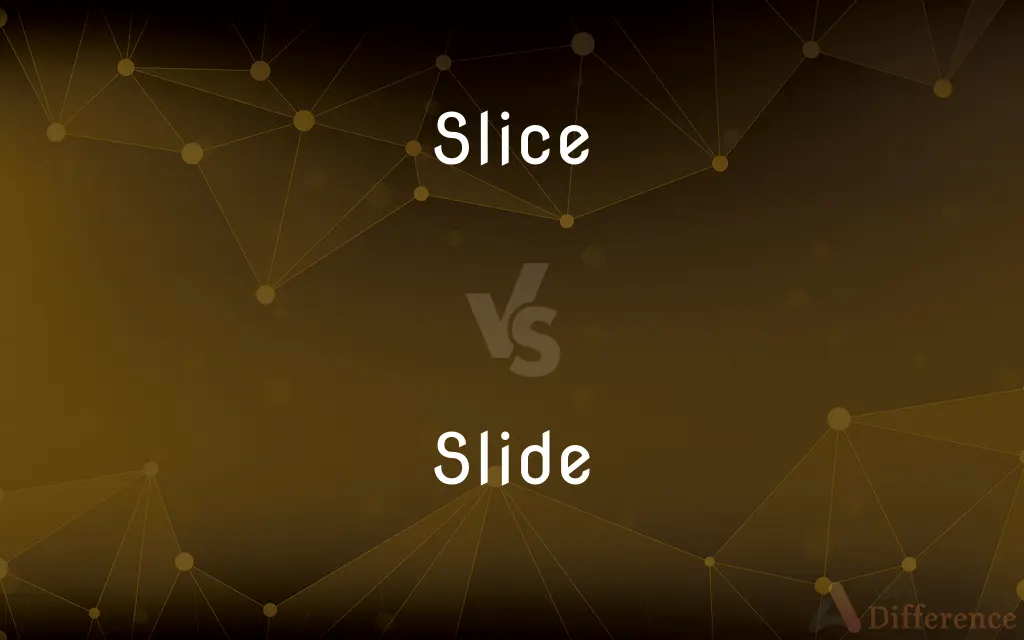Slice vs. Slide — What's the Difference?
By Maham Liaqat & Fiza Rafique — Updated on February 21, 2024
A slice is a thin, broad piece cut from a larger object, emphasizing the action of cutting, while a slide involves smooth movement across a surface, highlighting motion.

Difference Between Slice and Slide
Table of Contents
ADVERTISEMENT
Key Differences
A slice refers to a portion or piece that has been cut from something larger, typically using a sharp tool, and is often associated with food, like slicing bread or fruit. The term emphasizes the precision and action of cutting, producing thin sections suitable for serving or processing. In contrast, to slide means to move smoothly along a surface, often with continuous contact, and can refer to both intentional movements, such as sliding a drawer, and accidental ones, like slipping on ice.
Slicing involves a deliberate action with a tool, creating distinct pieces or sections from a whole, which requires a certain level of skill to achieve uniformity and precision. Sliding, however, depends more on the surface properties and the force applied, requiring less control over the outcome and often resulting in a more fluid motion.
In the culinary context, slicing is a fundamental technique that affects the texture and presentation of food, while sliding is rarely associated with cooking methods and more with the handling or transferring of items, such as sliding a pizza into an oven.
The outcome of slicing is tangible, producing visible and separate pieces, whereas sliding results in a change of position or location, with the object remaining intact. This distinction highlights the different purposes and results associated with each term.
Both terms imply an action, while their contexts and applications differ significantly. Slicing is about division and segmentation, often to prepare or consume, while sliding is about movement, often to position or relocate, showcasing their distinct roles in various activities.
ADVERTISEMENT
Comparison Chart
Definition
Cutting an item into thin, broad pieces.
Moving smoothly along a surface.
Primary Action
Cutting with a sharp implement.
Moving with continuous contact against a surface.
Contexts
Cooking, data segmentation, sports (golf).
Movement, photography, playgrounds, presentations.
Outcome
Separate pieces from the original item.
Change in position or location of an item.
Skill Required
Precision in cutting for uniformity.
Control over movement or force applied.
Compare with Definitions
Slice
A thin, broad piece cut from something larger.
She enjoyed a slice of homemade pie.
Slide
To move smoothly along a surface.
The child loved to slide down the playground slide.
Slice
To cut something into pieces using a sharp tool.
The chef sliced the vegetables finely for the salad.
Slide
A decline or decrease.
The company's stock began to slide after the announcement.
Slice
A stroke in sports that causes the ball to curve.
His golf slice sent the ball veering off to the right.
Slide
A transparent picture viewed through a projector.
The lecturer changed the slide to the next topic.
Slice
To divide or segment data or information.
The report was sliced into different thematic sections.
Slide
An item or mechanism that allows for sliding movement.
The drawer's slides were greased for smoother operation.
Slice
A portion or part of a whole.
A slice of the company's profits was reinvested into research.
Slide
To slip or fall accidentally on a slippery surface.
She slid on the icy sidewalk but wasn't hurt.
Slice
A thin, broad piece of food, such as bread, meat, or cake, cut from a larger portion.
Four slices of bread.
Potato slices.
Slide
To slip when walking or standing; to fall.
Their foot shall slide in due time.
Slice
To make a cut with a cutting implement.
I sliced into the cake.
Slide
To move over a surface while maintaining smooth continuous contact.
Slice
To cut into parts; to divide.
Slide
To participate in a sport that involves such movement.
Sliding for a medal in luge.
Slice
A utensil with a broad, flat blade for lifting foods such as cake and fish.
Slide
A sliding movement or action.
Slice
A thin, broad piece cut off; as, a slice of bacon; a slice of cheese; a slice of bread.
Slide
To drop down and skid into a base.
Jones slid into second.
Slice
A thin flat piece cut off of some object.
Slide
To pass or move unobtrusively or smoothly.
They slid through the wicket in the big gate.
Common Curiosities
What skills are required for slicing in a culinary context?
Precision, control, and technique in using a knife to ensure even and consistent cuts.
Can "slice" and "slide" be used interchangeably in any context?
No, they denote different actions and are used in distinct contexts, making them non-interchangeable.
Are there specific tools associated with slicing?
Yes, various knives and cutting tools are designed for slicing, such as chef's knives and mandolines.
What is the primary difference between a slice and a slide?
A slice refers to cutting into thin pieces, while a slide involves moving smoothly along a surface.
What are some safety considerations when sliding?
Ensuring the surface is safe and free of hazards, and using appropriate footwear or equipment to prevent accidents.
Is there a specific technique to improve slicing skills?
Practicing consistent cutting motions, maintaining sharp tools, and learning various cutting techniques can improve slicing skills.
Can the term "slice" be used in digital contexts?
Yes, "slice" can refer to segmenting digital data or images into smaller, manageable parts.
How does sliding motion occur?
Sliding motion occurs when an object moves along a surface with minimal resistance, often facilitated by smooth surfaces or lubrication.
What factors affect the ease of sliding an object?
Surface texture, the weight of the object, and the presence of lubricants can significantly affect sliding ease.
How can one prevent unintended sliding?
Using non-slip mats, wearing appropriate footwear, and maintaining clean, dry surfaces can help prevent unintended sliding.
Share Your Discovery

Previous Comparison
Peridural vs. Epidural
Next Comparison
Noble vs. NobelAuthor Spotlight
Written by
Maham LiaqatCo-written by
Fiza RafiqueFiza Rafique is a skilled content writer at AskDifference.com, where she meticulously refines and enhances written pieces. Drawing from her vast editorial expertise, Fiza ensures clarity, accuracy, and precision in every article. Passionate about language, she continually seeks to elevate the quality of content for readers worldwide.















































